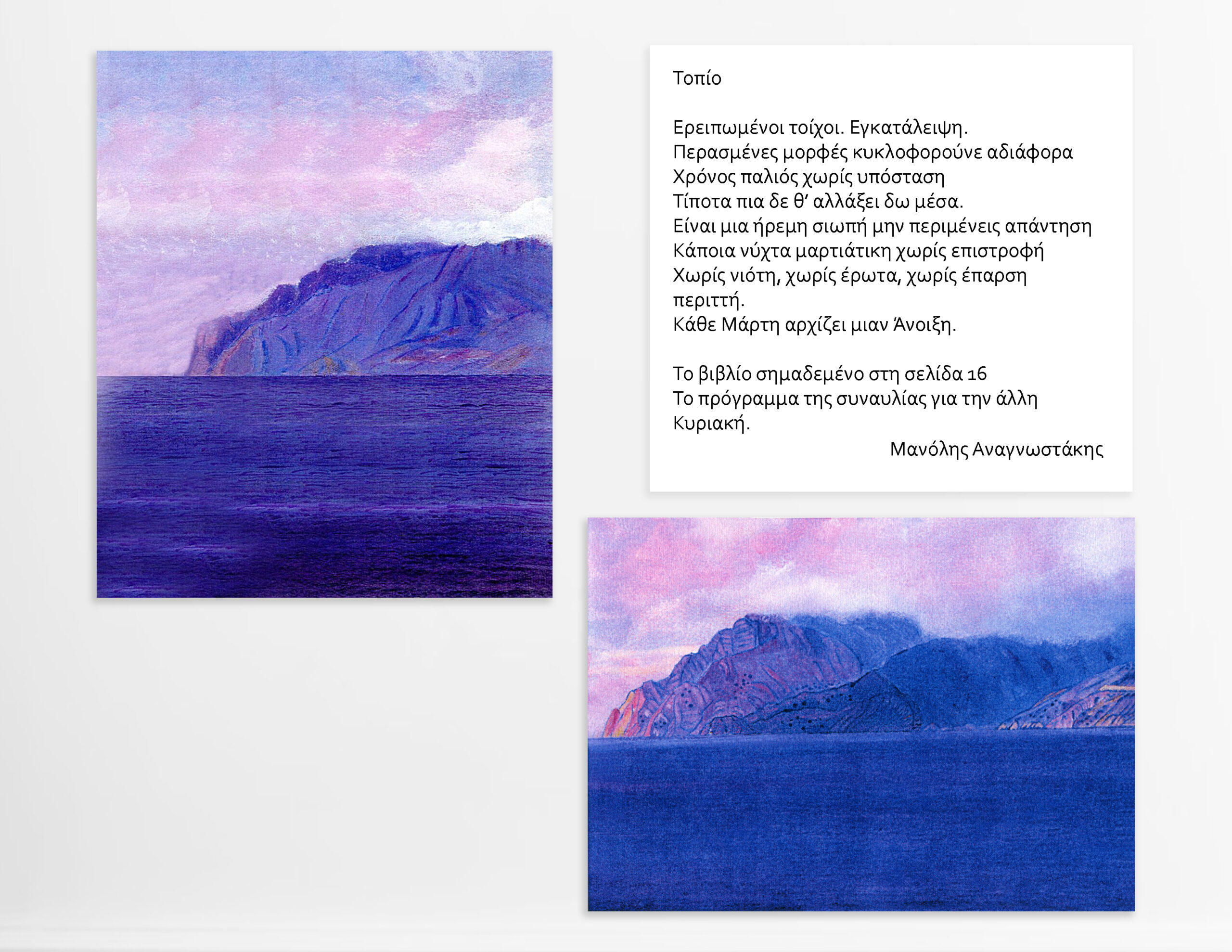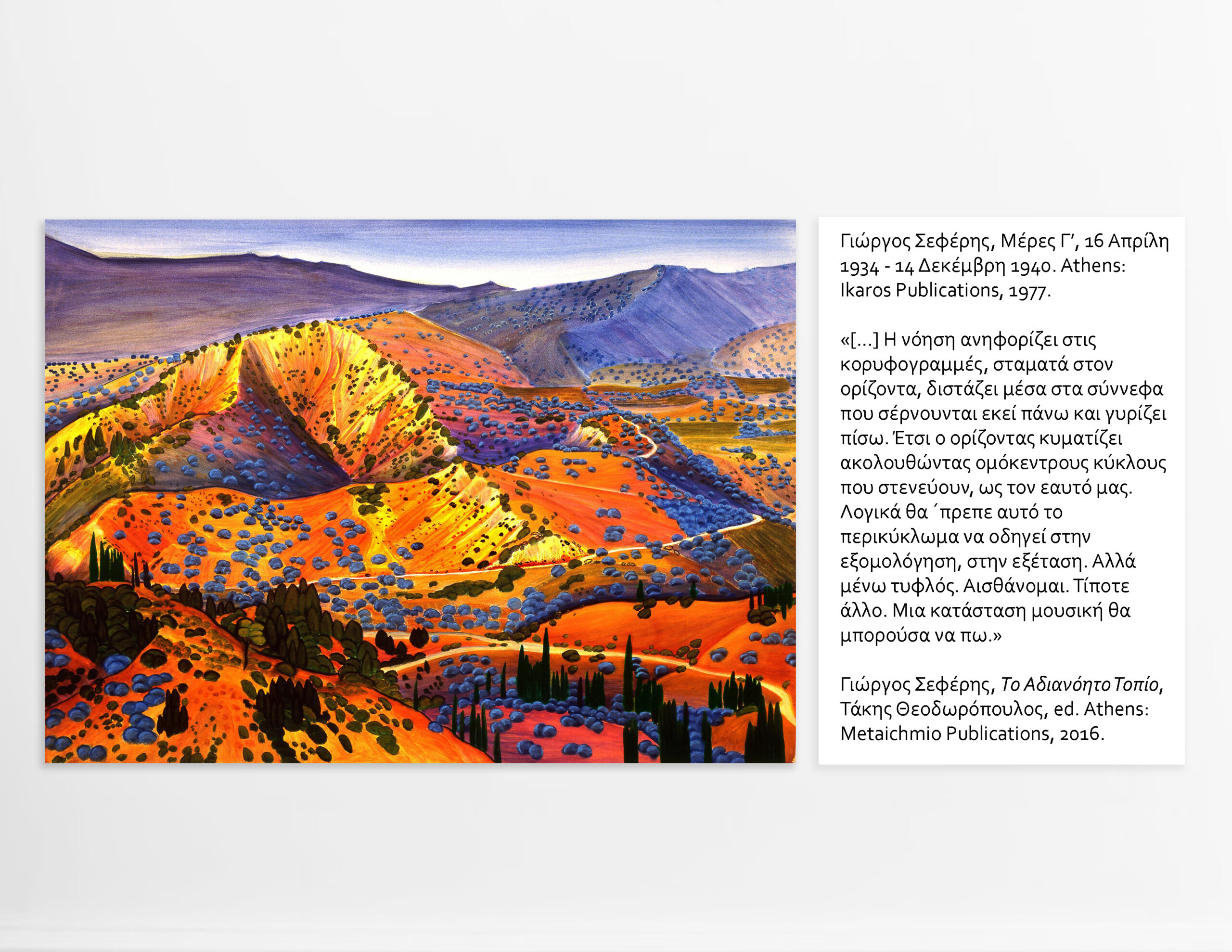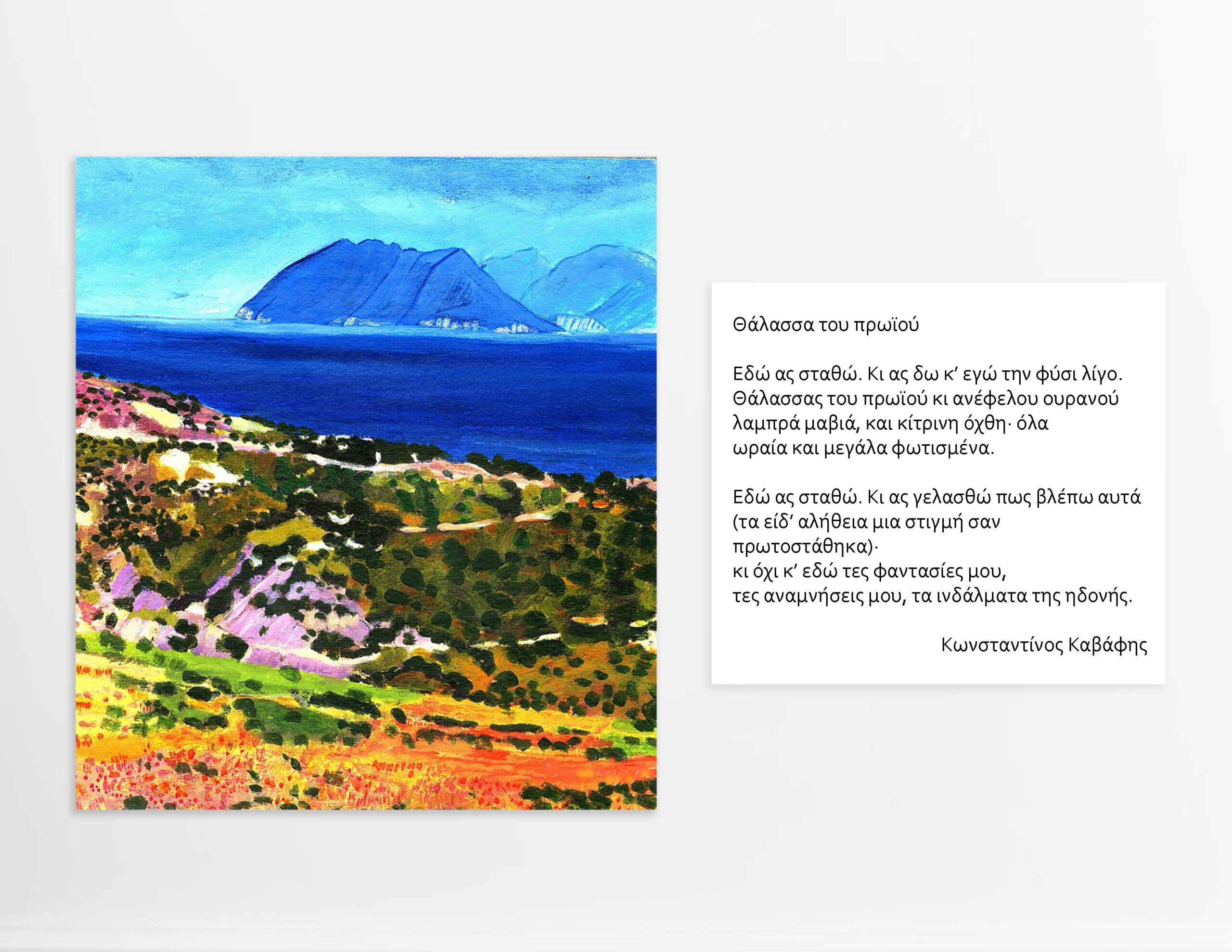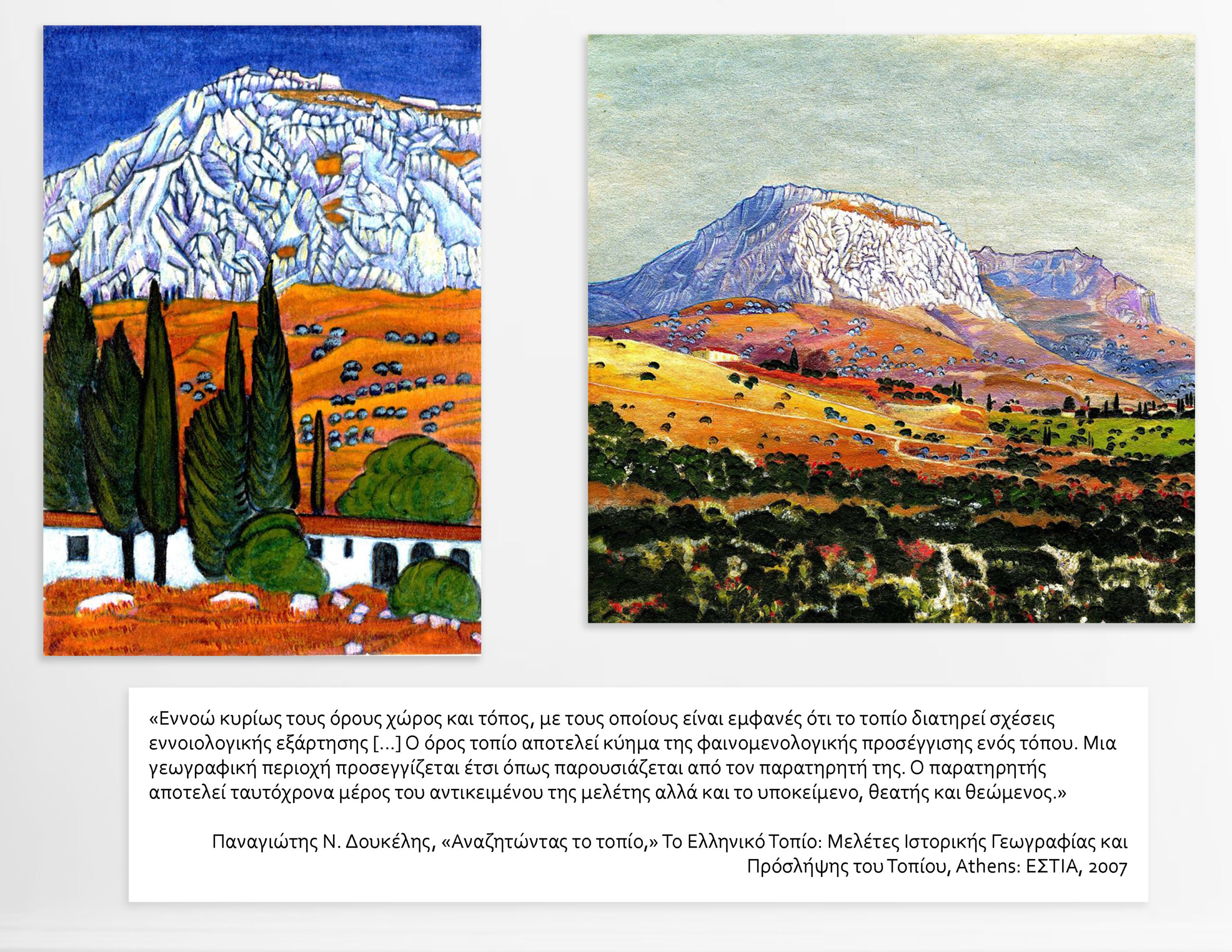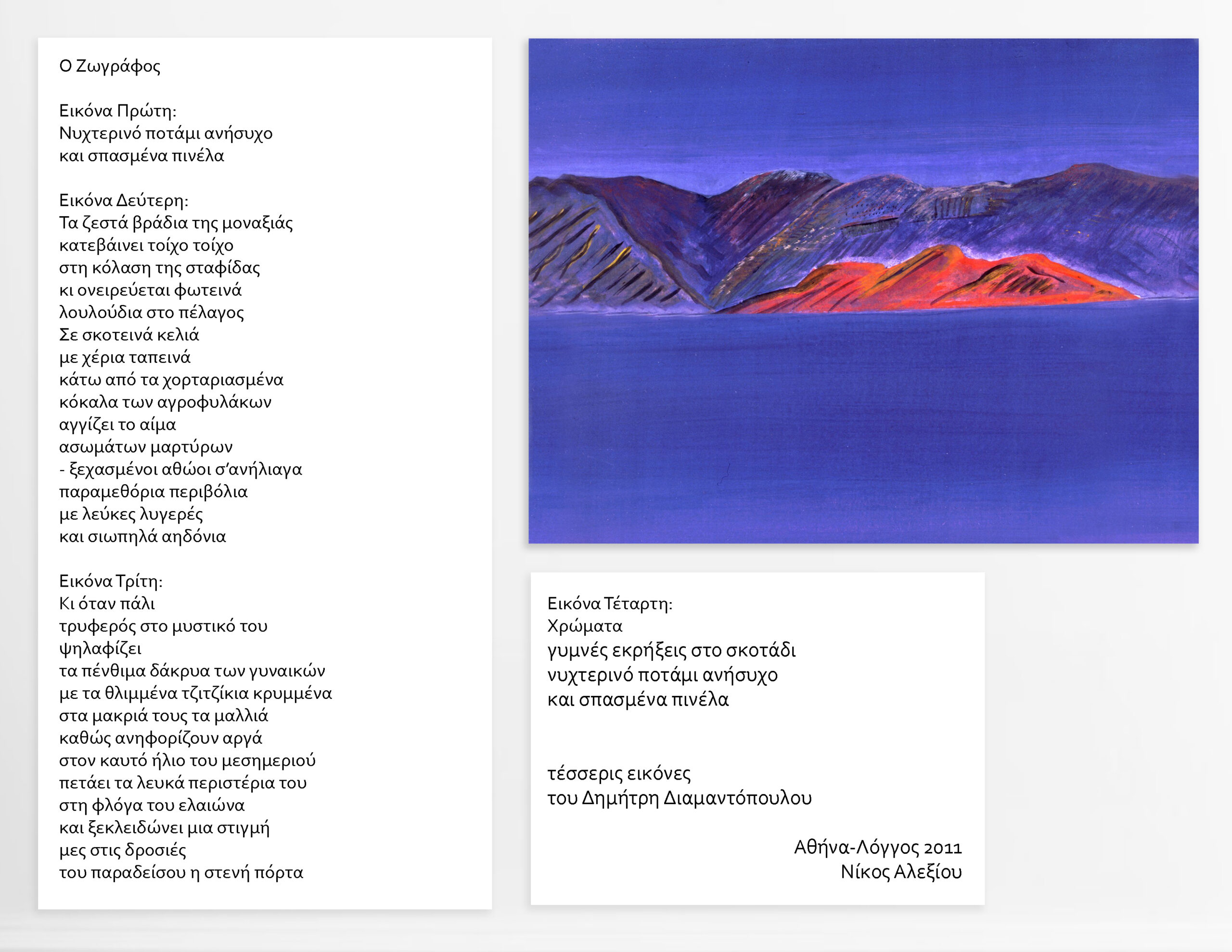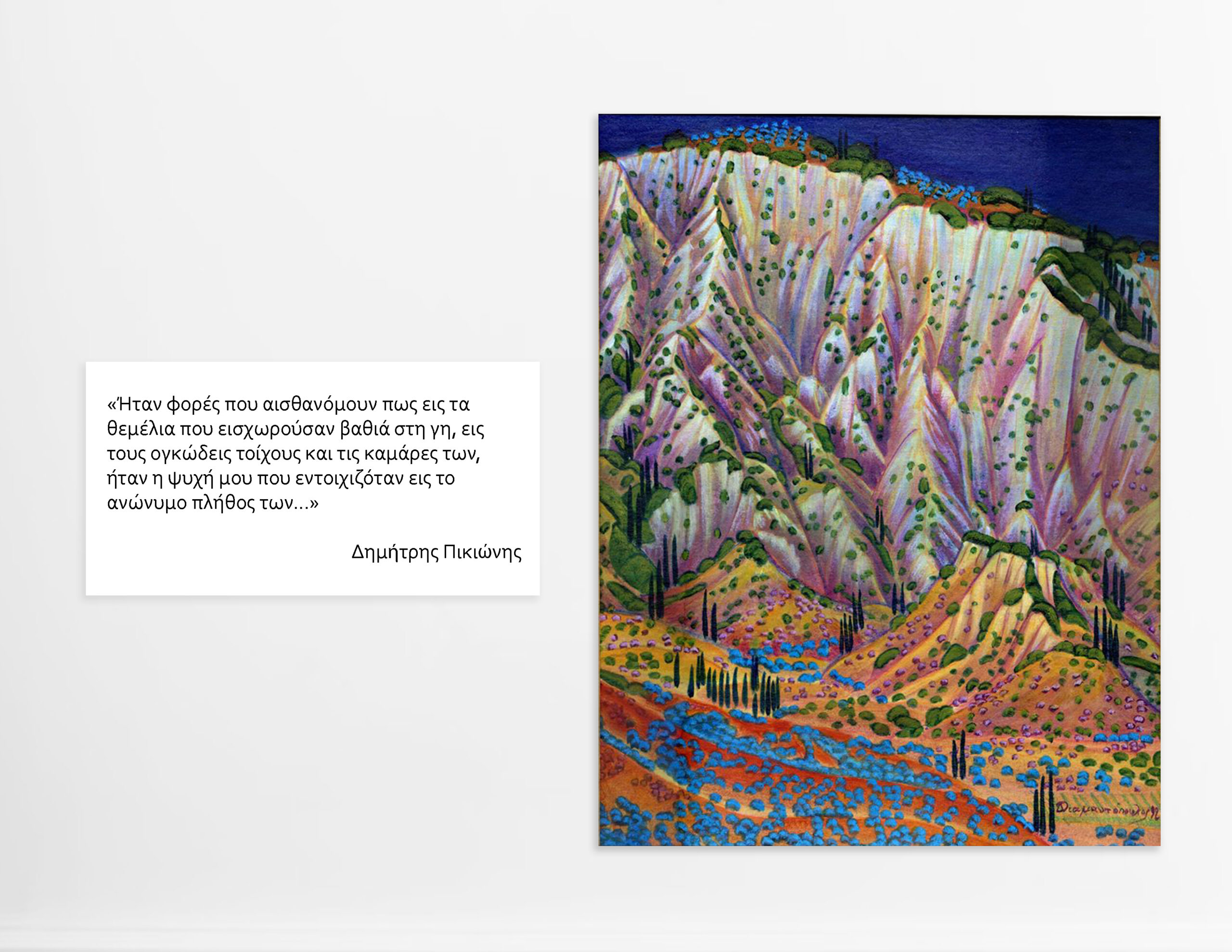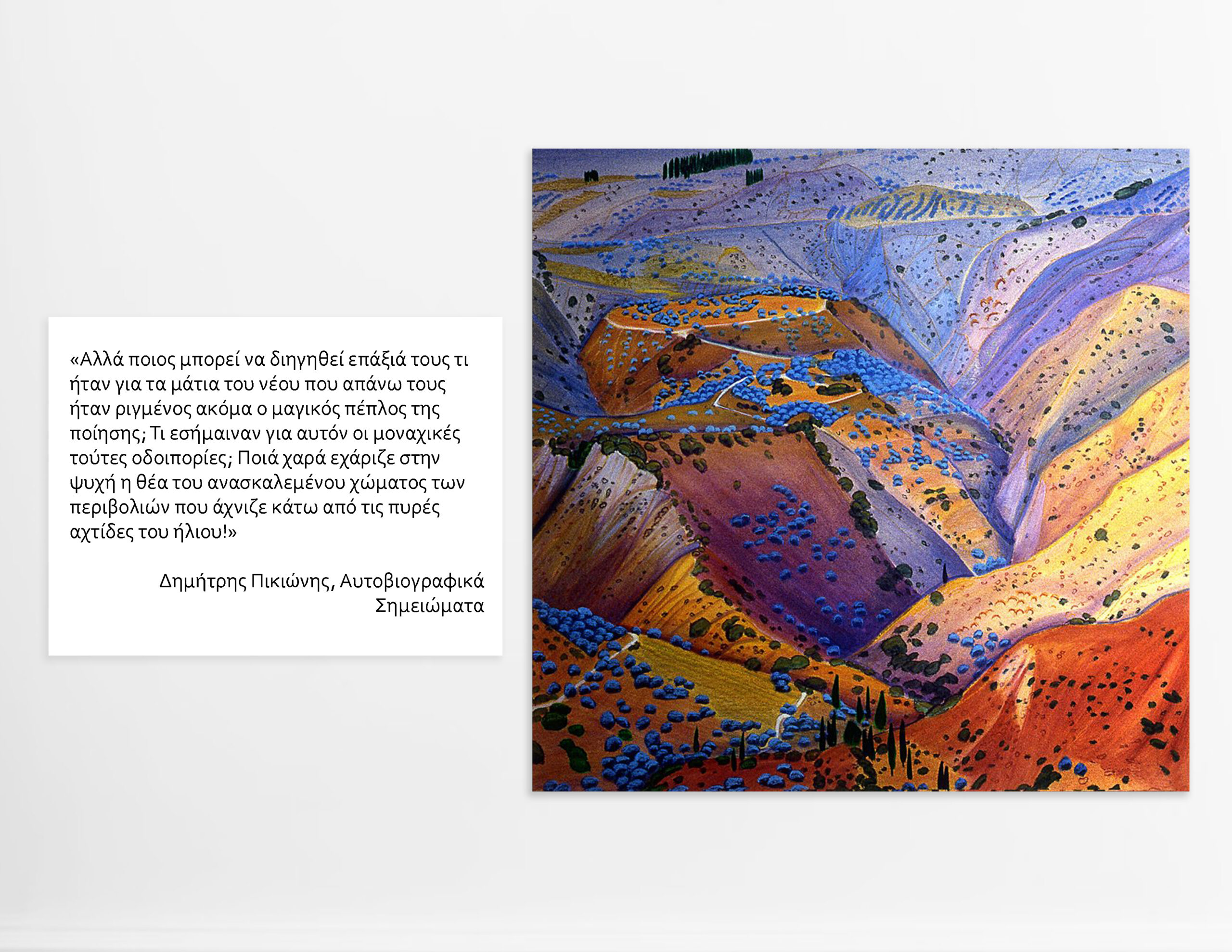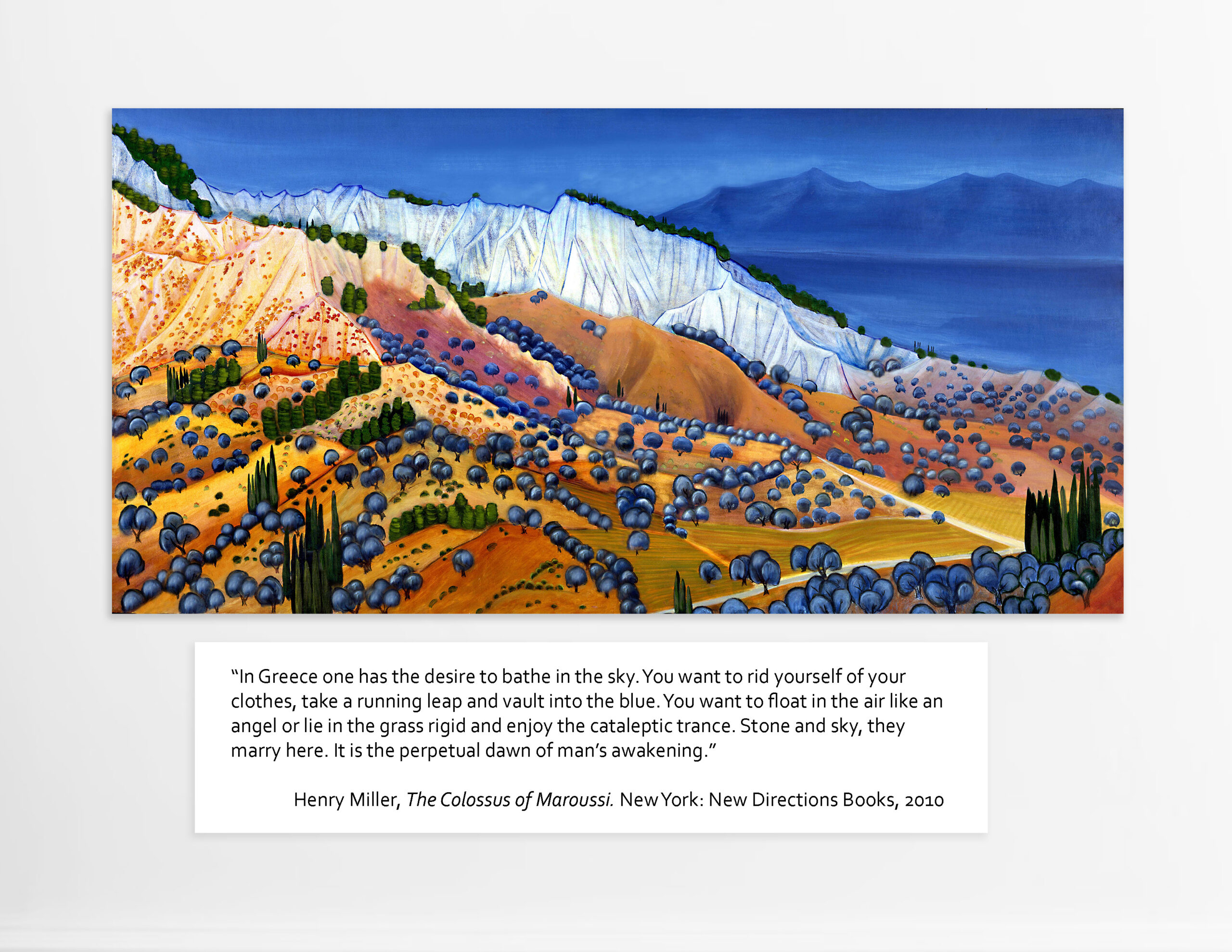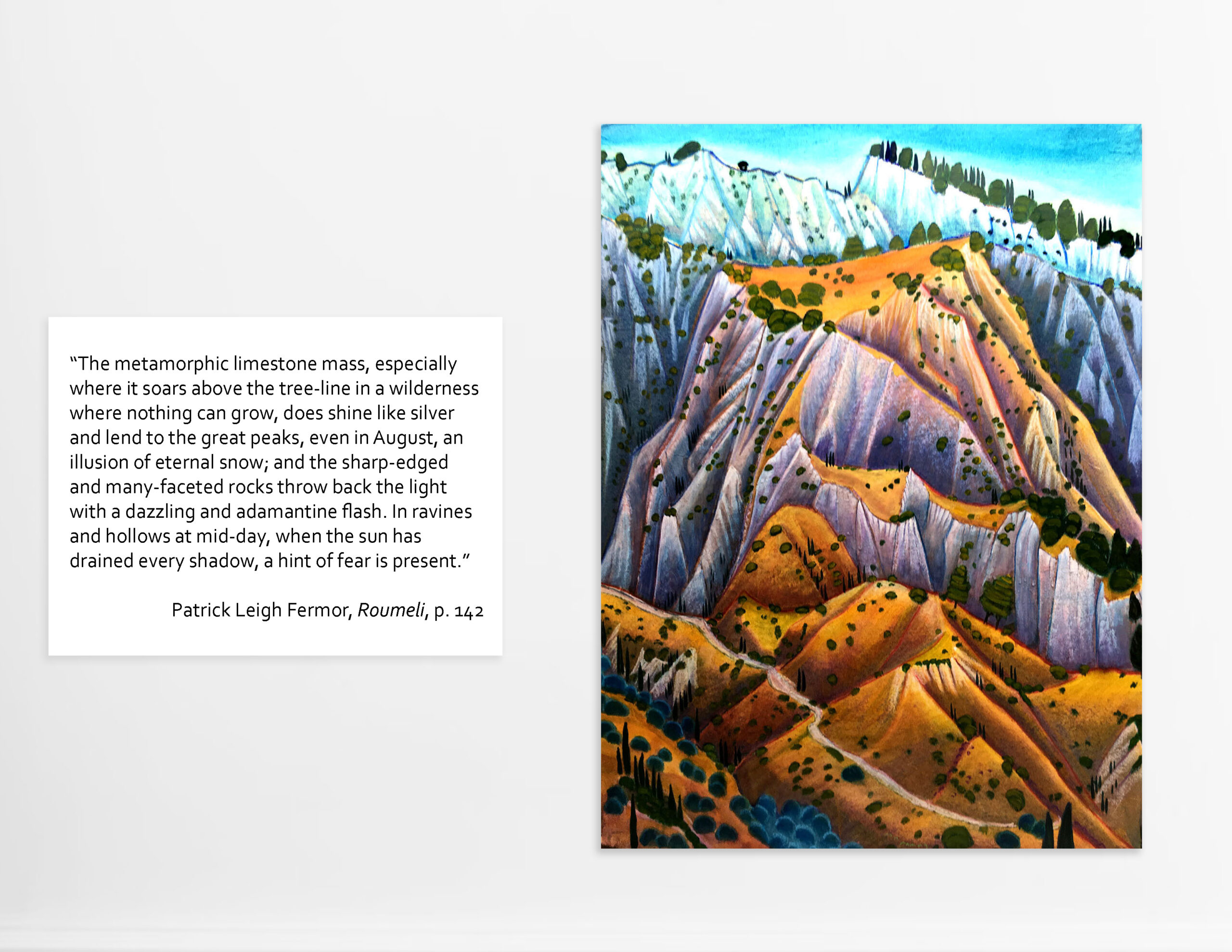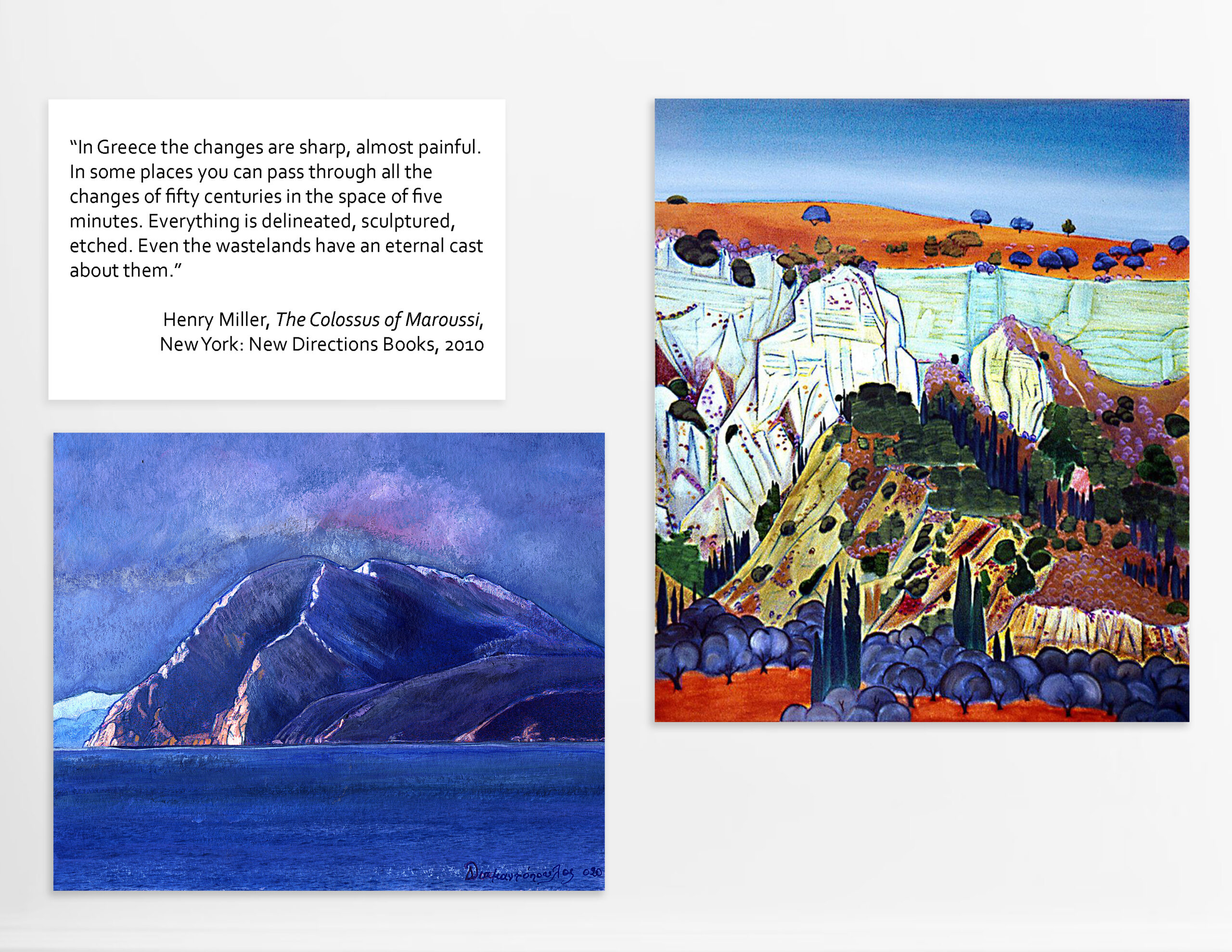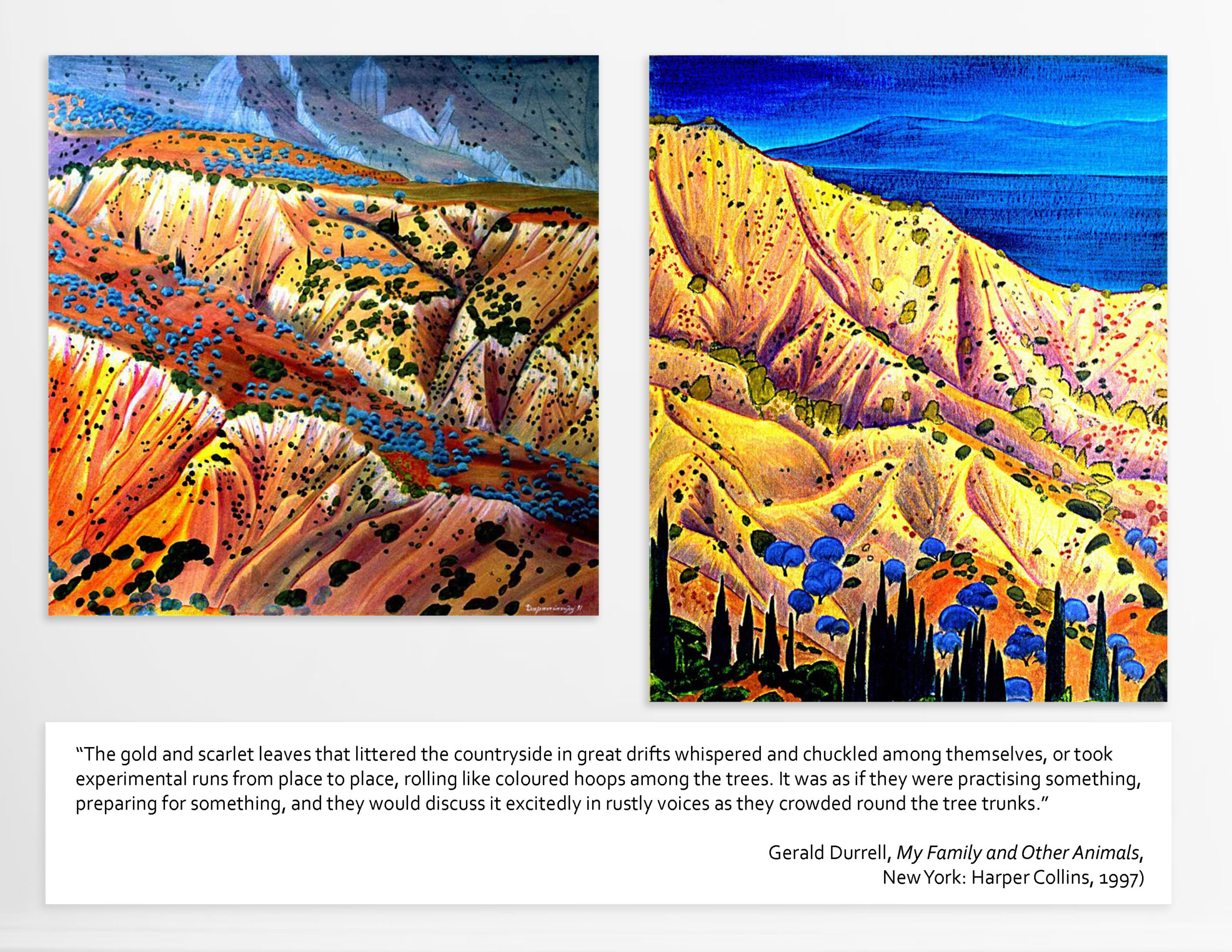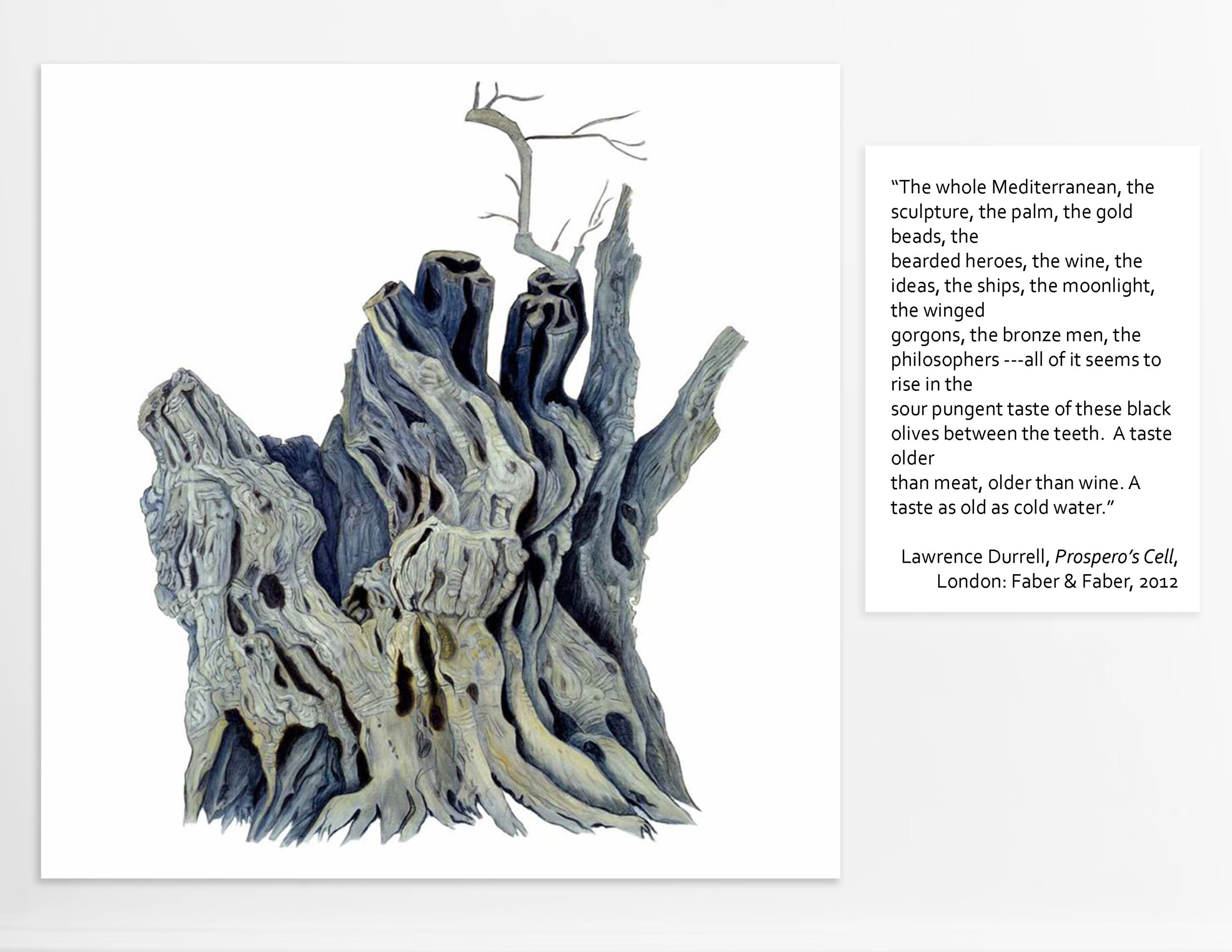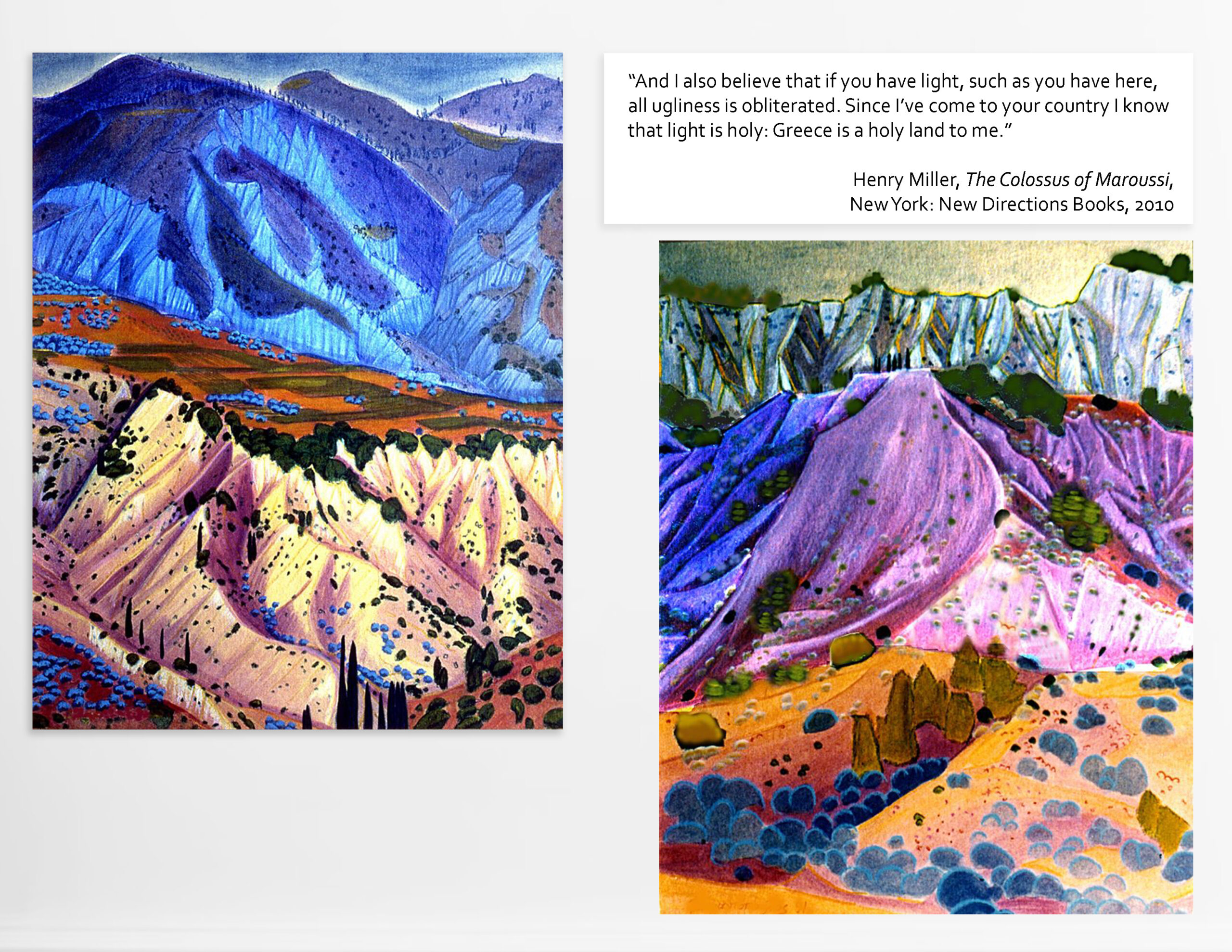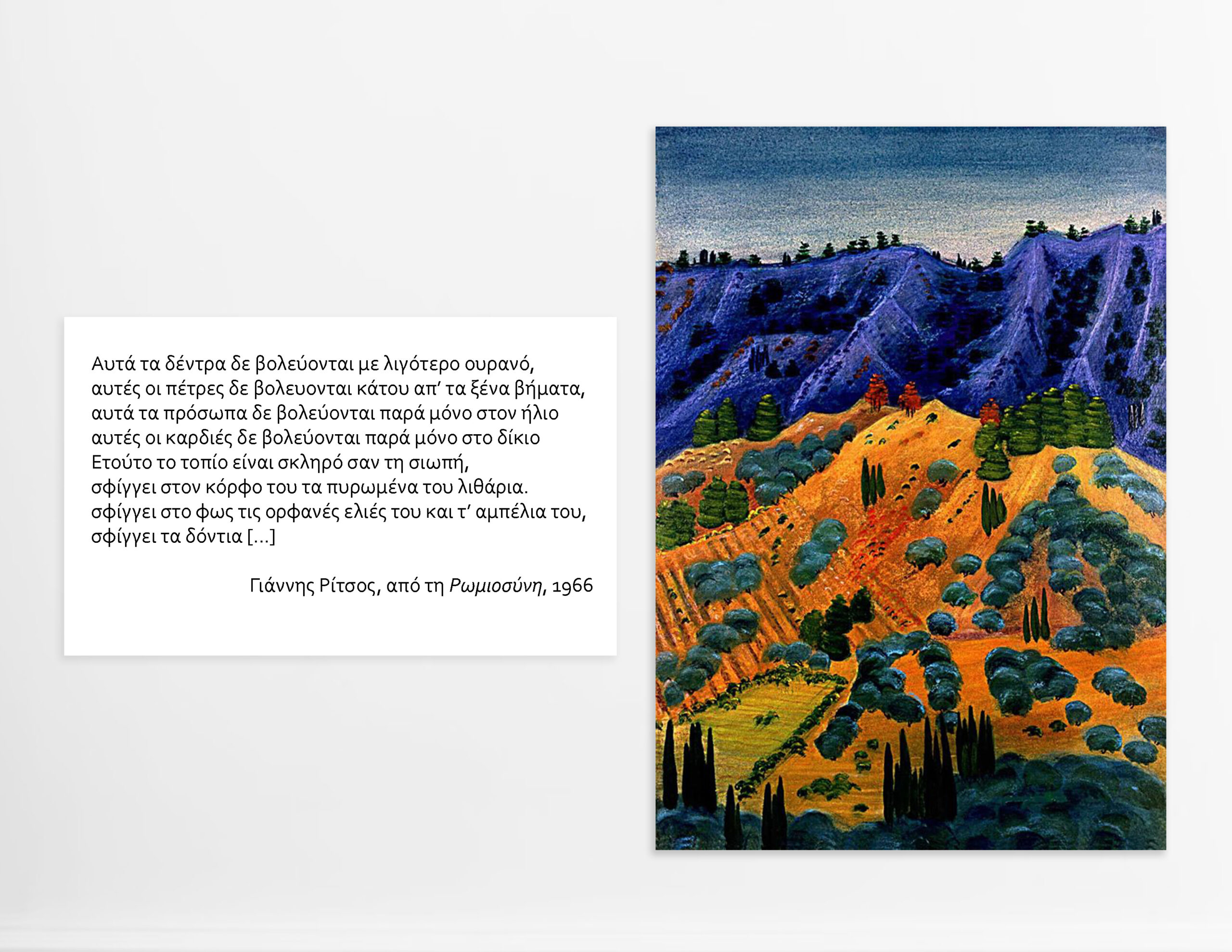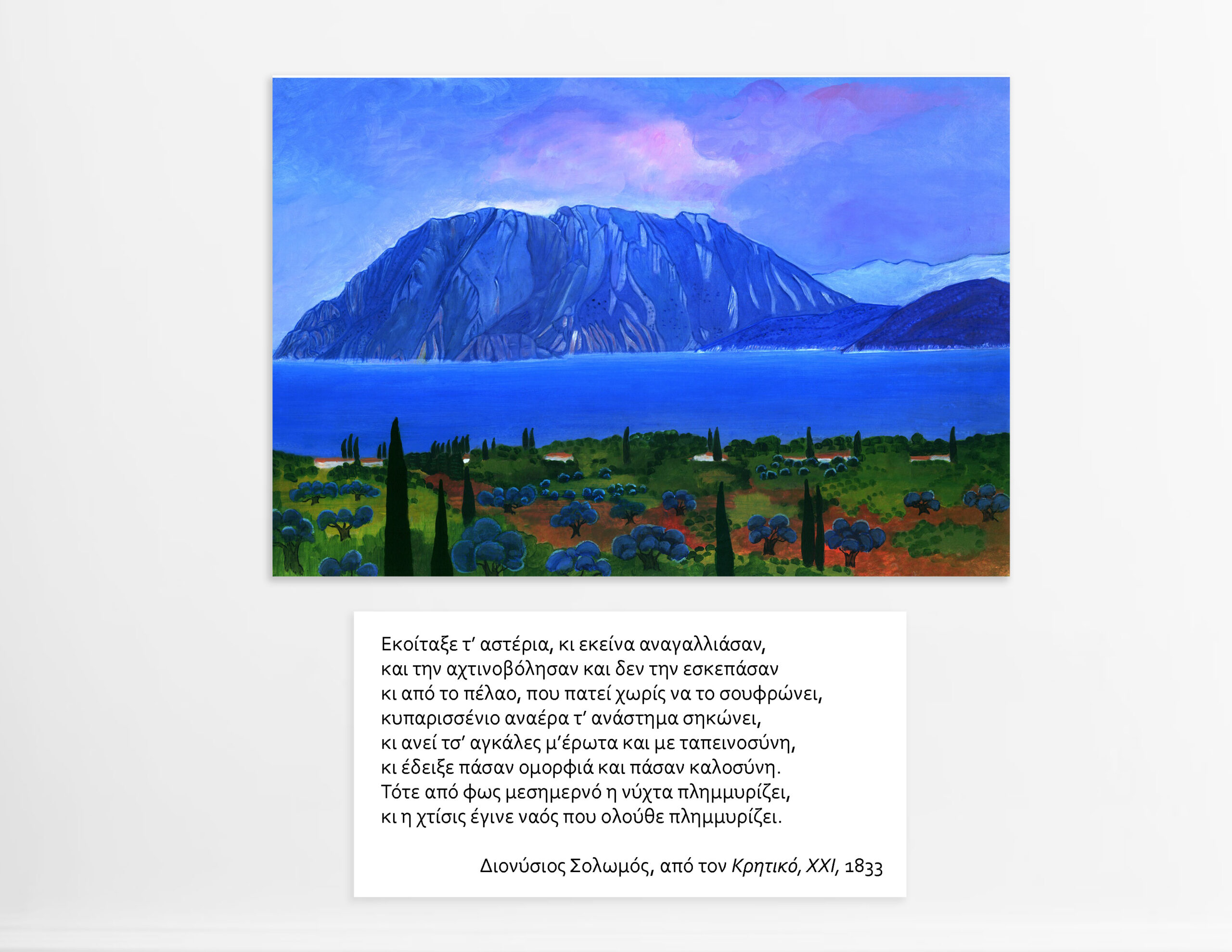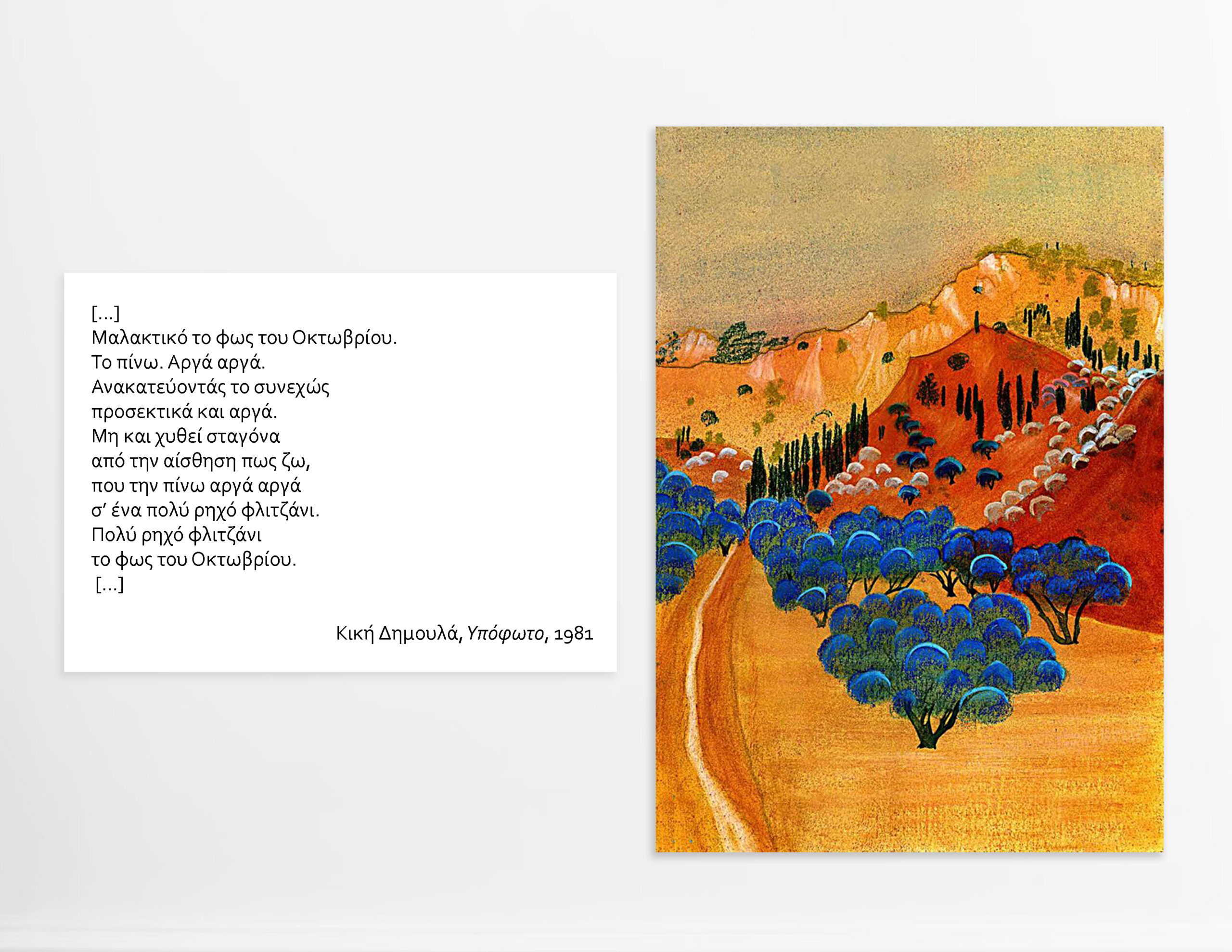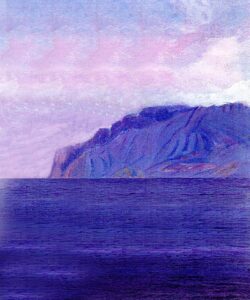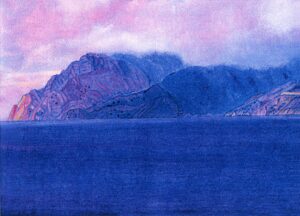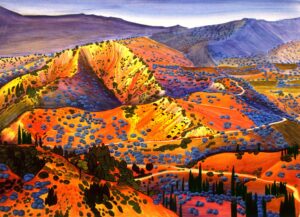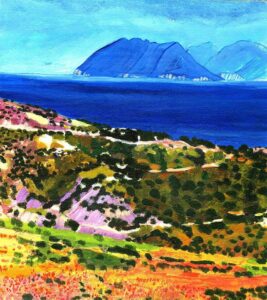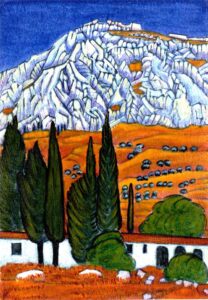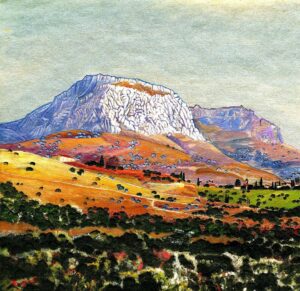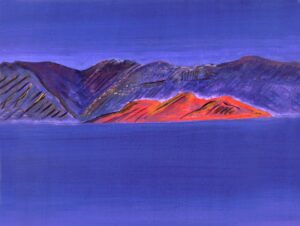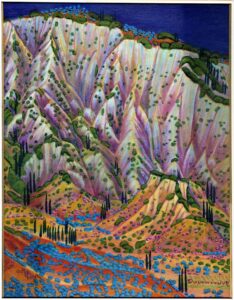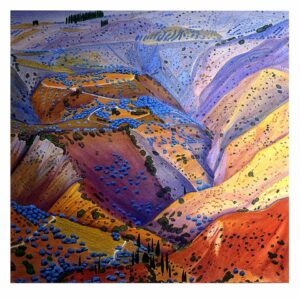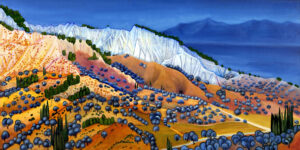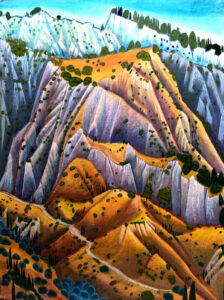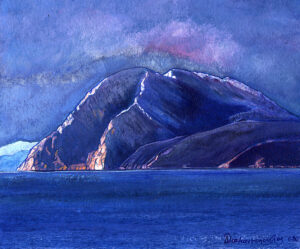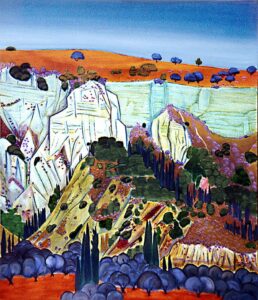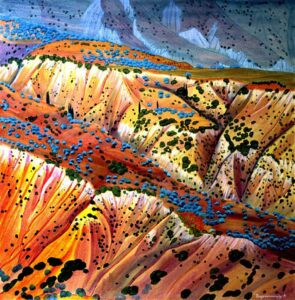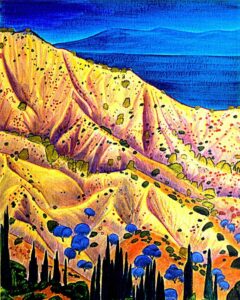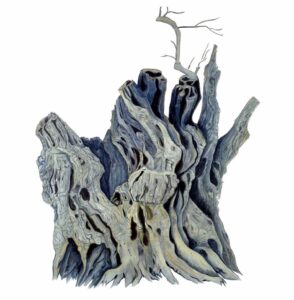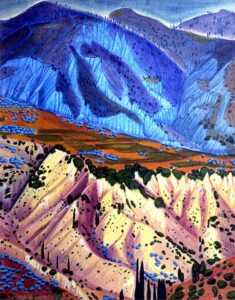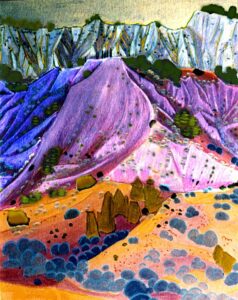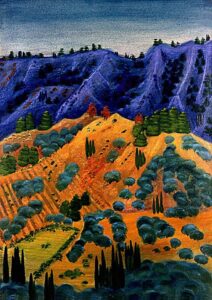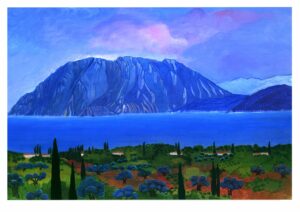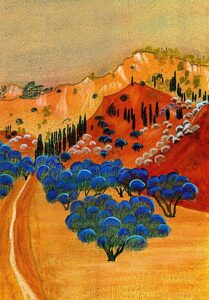Ode to the Greek Light and Landscape
Works by Dimitris Diamantopoulos
The Hellenic American Project (HAP) at Queens College presents the virtual exhibition Ode to the Greek Light and Landscape: Works by Dimitris Diamantopoulos.
Diamantopoulos was invited to present the 21 paintings featured in the exhibition to commemorate 200 years since the start of the Greek War for Independence in 1821.
Poems and written passages inspired by the natural elements in the landscape of Greece are presented alongside the works, which Diamantopoulos created over a 30-year span, beginning in 1990. Diamantopoulos’ use of water-based acrylic, egg tempera, the lazure technique, and lithography enable him to create works of varying color density, intensity, and texture. Through these painting methods, he is able to capture elusive aspects of the natural landscape and phos (light) of Greece on paper. The specially selected poems and book passages accompanying each painting are evocative of the nuances in Diamantopoulos’ work, which depicts areas from the region of the Northern Peloponnese.
This exhibition is the second such presentation by HAP offered in response to the unique challenges presented by COVID-19 imposed restrictions on public gatherings. It seeks to inspire viewers with a sense of hope, an appreciation for meaningful human connections, and virtually transport them at a time of unprecedented individual isolation and widespread public upheaval.
The exhibition was first made publicly available on the HAP site on October 30, 2020. It is co-curated by Nicholas Alexiou, founder and director of the Hellenic American Project, and Tiffany Apostolou, curator and art historian.
Το Hellenic American Project (HAP), Queens College, CUNY, παρουσιάζει την εικονική έκθεση: Ωδή στο Ελληνικό Φως και Τοπίο Έργα του Δημήτρη Διαμαντόπουλου.
Ο ζωγράφος Δημήτρης Διαμαντόπουλος προσκλήθηκε να παρουσιάσει 21 πίνακες για να τιμήσουμε την επέτειο των 200 ετών από την έναρξη της Ελληνικής Επανάστασης για Ανεξαρτησία.
Ποιήματα και γραπτά αποσπάσματα εμπνευσμένα από τα φυσικά στοιχεία του τοπίου της Ελλάδας παρουσιάζονται παράλληλα με τα έργα, τα οποία δημιούργησε ο Διαμαντόπουλος σε μια περίοδο 30 ετών, ξεκινώντας το 1990. Με την χρήση ακρυλικών, αυγοτέμπερας, της τεχνικής της λαζούρας, και της λιθογραφίας, ο Διαμαντόπουλος κατάφερε να δημιουργήσει έργα ποικίλης χρωματικής πυκνότητας, έντασης και υφής. Μέσω των συγκεκριμένων μεθόδων ζωγραφικής, ο καλλιτέχνης είναι σε θέση να συλλάβει αόρατες πτυχές του φυσικού τοπίου και του φωτός της Ελλάδας σε χαρτί. Τα ειδικά επιλεγμένα ποιήματα και αποσπάσματα βιβλίων που συνοδεύουν τους πίνακες, υποδηλώνουν τις αποχρώσεις στο έργο του Διαμαντόπουλου, που απεικονίζουν περιοχές από την περιοχή της Βόρειας Πελοποννήσου.
Η παρούσα έκθεση είναι η δεύτερη κατά σειρά παρουσίαση από το HAP, και θεωρείται ως απάντηση στις μοναδικές προκλήσεις που αντιμετωπίζουμε στην περίοδο του COVID-19, και την επιβολή περιορισμών δημοσίων συγκεντρώσεων. Η έκθεση με θέμα το Ελληνικό Φως και Τοπίο, στοχεύει να εμπνεύσει και να δημιουργήσει μια αίσθηση ελπίδας. Να συμπληρώσει το κενό που δημιουργήθηκε στις κοινωνικές σχέσεις, σε μια εποχή ατομικής απομόνωσης και εκτεταμένης κοινωνικο-πολιτικής αναταραχής και οικονομικής κρίσης.
Η έναρξη της έκθεσης πραγματοποιήθηκε στις 30 Οκτωβρίου, 2020, και αναρτήθηκε στην ιστοσελίδα του HAP. Την επιμέλεια της έκθεσης ανέλαβαν ο Νίκος Αλεξίου, ιδρυτής και διευθυντής, και η Φανή Αποστόλου, επιμελήτρια και ιστορικός τέχνης.
Artist Dimitris Diamantopoulos's Bio
Dimitris Diamantopoulos is a Greek visual artist who has worked extensively in the U.S. He studied in Athens and New York (S.U.N.Y.) His work applies to the fine arts, and extends to architectural design and models, interior design, jewelry, sculpture and painting. Diamantopoulos knowledge and use of a wide variety of materials in the applied arts has played an important role in shaping and enriching the artistic expression in his painting practice.
Dimitris Diamantopoulos seeks the essence of the Greek landscape through color and light through his paintings. He has developed unique landscape painting practice over many years, focusing primarily on the areas of Corinthia and Achaia in the Peloponnese, where he was born. His personal artistic language draws from many sources across the Greek cultural tradition.
Dimitris Diamantopoulos’ works have been shown in numerous solo and group exhibitions in Greece, as well as in cities in Europe and the United States.
12/16/2020 Professor Nicholas Alexiou’s Interview with Artist Mr. Dimitris Diamantopoulos
Installation Photos
The Landscape
Ruined walls. Abandonment.
Past forms move about indifferently
Old time without substance
Nothing will change in here anymore.
It is a calm silence do not wait for a response
A March evening that will never return
Without youth, without love, without unnecessary arrogance.
Every March a spring begins.
The book marked on page 16
Next Sunday’s concert program
“The mind ascends to the mountain ridges, stops at the horizon, hesitates within the clouds that crawl up there, and returns. Thus, the horizon ripples following narrowing concentric circles until it reaches our person. Logically, this encirclement should lead to confession, to self-examination. But I remain blind. I feel. Nothing else. A musical state I could say.” George Seferis
Let me stop here. Let me, too, look at nature awhile.
The brilliant blue of the morning sea, of the cloudless sky,
the yellow shore; all lovely
all bathed in light.
Let me stand here. And let me pretend I see all this
(I really did see it for a minute when I first stopped)
and not my usual day-dreams here too,
my memories, those images of sensual pleasure.
transl. by Edmund Keeley and Philip Sherrard, poem by Constantine Kavafy
I mainly mean the terms space [choros] and place [topos], with which it is obvious that the landscape maintains a conceptual dependence […] The term landscape [topio] is a product of the phenomenological approach of a place [topos]. A geographical area can be approached as it is presented by its observer. The observer is simultaneously a part of the study but also its subject, both viewer and viewed.”
Panayiotis Doukelis, Athens: Estia, 2007
Image one:
Restless nighttime river
and broken brushes.
Image two:
The warm nights of loneliness,
along the wall, he descends
into the hell of the vineyards
and dreams of
bright flowers on the open sea.
In dark cells
with humble hands
underneath the mossy bones
of county sheriffs
he touches the blood
bodiless martyrs
– forgotten innocent in sunless
frontier fields
of slender poplars
and songless nightingales.
Image Three:
And when again,
tender in his secret,
he strokes
the mournful tears of women
with sorrowful cicadas hidden
in their long hair
as they slowly ascend
in the hot midday sun,
he tosses his white doves
into the flaming olive grove
with a breeze
the narrow door of heaven
unlocks for a moment.
Image Four:
Colors
naked explosions in the dark
restless nighttime river
and broken brushes
Four images
of Dimitris Diamantopoulos
Athens-Loggos 2011
Nicholas Alexiou
“There were moments when I felt that my soul was embedded within the anonymous crowding of the foundations that penetrated deep into the land, the bulky walls and their arches.”
Dimitris Pikionis
“But who can narrate justly, what it was for the eyes of a youth that were still covered by the magical peplum of poetry? What did those solitary hikes mean to him? What joy did the view of the excavated soil of the orchards gift his soul under the fiery rays of the sun?”
Dimitris Pikionis, Autobiographical Notations
«Στην Ελλάδα έχει κανείς την επιθυμία να λουστεί τον ουρανό. Θέλεις να ξεφορτωθείς τα ρούχα, και τρέχοντας να κάνεις άλμα μέσα στο μπλε. Θέλεις να αιωρηθείς στον αέρα σαν άγγελος ή να ξαπλώσεις στο άγριο χορτάρι και να απολαύσεις καταληπτική έκσταση. Εδώ πέτρα και ουρανός παντρεύονται. Είναι η συνεχής αυγή της αφύπνισης του ανθρώπου.»
Henry Miller, Ο Κολοσσός του Αμαρουσίου.
«Η μεταμορφική ασβεστολιθική μάζα, ειδίκα εκεί που πετά ψηλότερα από τη κορυφογραμμή των δέντρων σε ερημιά που τίποτα δεν μπορεί να μεγαλώσει, λάμπει σαν ασήμι και δανείζει στις μεγάλες κορυφές, ακόμα και τον Αύγουστο, μια ψευδαίσθηση αιώνιου χιονιού΄και η αιχμηρές και πολύπλευρες πέτρες αντανακλούν το φως με εκθαμβωτική και αδαμάντινη λάμψη. Σε χαράδρες και κοίλες το μεσημέρι, όταν ο ήλιος έχει εξαλείψει κάθε σκιά, ένα ίχνος φόβου είναι παρών.»
Patrick Leigh Fermor, Ρούμελη.
«Στην Ελλάδα, οι αλλαγές είναι αιχμηρές, σχεδόν πονούν. Σε μερικά μέρη μπορείς να περάσεις μέσα από τις αλλαγές πενήντα αιώνων στο διάστημα πέντε λεπτών. Όλα διαγράφονται ως γλυπτά, ως χαρακτικά. Ακόμα και οι χερσότοποι αναδύουν μια αιώνια ατμόσφαιρα.»
Henry Miller, Ο Κολοσσός του Αμαρουσίου.
«Τα χρυσά και τα κόκκινα φύλλα σκόρπια στην ύπαιθρο σε μεγάλες εκτροπές ψιθύριζαν και γελούσαν μεταξύ τους, ή έπαιρναν σειρές τρέχοντας από μέρος σε μέρος, κυλιόμενες στεφάνες ανάμεσα στα δέντρα. Ήταν σαν να έκαναν εξάσκηση για κάτι, σαν να προετοιμάζονταν για κάτι, και συζητούσαν με ψιθυριστές φωνές καθώς συγκεντρώνονταν γύρω από τους κορμούς των δέντρων.»
Gerald Durrell, Η Οικογένεια μου και άλλα Ζώα.
«Ολόκληρη η Μεσόγειος, η γλυπτική, ο φοίνηκας, οι χρυσές χάντρες, οι μουσάτοι ήρωες, το κρασί, οι ιδέες, τα πλοία, το φεγγαρόφως, οι φτερωτές γοργόνες, οι μπρούτζινοι άνδρες, οι φιλόσοφοι – όλα μαζί μοιάζουν να αναδύονται στη ξυνή, δυνατή γεύση ετούτων των μαύρων ελιών ανάμεσα στα δόντια. Μια γεύση παλαιότερη από το κρέας, παλαιότερη από το κρασί. Μια γεύση τόσο παλαιά όσο το κρύο νερό.»
Lawrence Durrell, London: Faber & Faber, 2012.
«Και πιστεύω πως αν έχεις φως, σαν αυτό που έχετε εδώ, όλη η ασχήμια εξαλείφεται. Από τότε που ήρθα στη χώρα σας γνωρίζω πως το φως είναι ιερό. Η Ελλάδα είναι ιερός τόπος για μένα.»
Henry Miller, Ο Κολοσσός του Αμαρουσίου.
Romiosini [Greekness]
These trees don’t take comfort in less sky,
these rocks don’t take comfort under foreign footsteps,
these faces don’t take comfort but only in the sun
these hearts don’t take comfort except in justice
This landscape is merciless like silence,
it embraces its fiery rocks tightly in its bosom
it embraces tightly in the sun its orphan olive trees and vineyards,
it clenches its teeth […] (excerpt)
She looked at the stars, and they rejoiced,
and they shined her and did not cover her
and from the sea, that she steps on without straining it,
she lifts the stature airily like a cypress,
and blooms my embrace with love and humility,
and showed all beauty and all kindness.
Then from the midday light the night is flooded,
and creation became a temple flooding from everywhere.
Excerpt. Dionysios Solomos, The Cretan, XXI, 1883
[…]
Emollient the light of October
I drink it. Slowly.
Mixing it continuously
carefully and slowly.
Lest a drop is wasted
from this sense that I am alive,
which I drink slowly.
A very shallow cup
the light of October. […]
Kiki Demoula, Dim Light, 1981
Individual Works
Acknowledgements
“We would like to extend our heartfelt gratitude to Ying Zhou, Executive Director of the Tech Incubator at Queens College and Cynthia Lopez who helped us put this exhibition up in the best way we could possibly imagine.
Further, we would like to thank Queens College, CUNY for providing us the virtual space and therefore presenting this exhibition in a new way of experiencing art, when in Covid-19 health restrictions, seeing it in a physical location is not yet permitted.”

